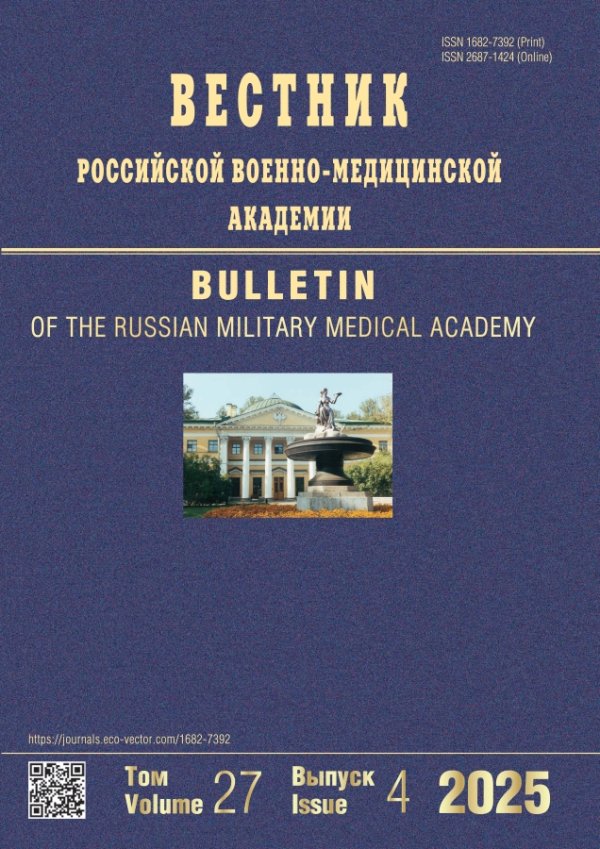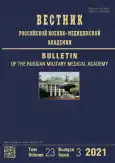Трансдифференциация стволовых клеток. От клетки к организму
- Авторы: Москалев А.В.1, Гумилевский Б.Ю.1, Апчел В.Я.1,2, Цыган В.Н.1
-
Учреждения:
- Военно-медицинская академия имени С.М. Кирова МО РФ
- Российский государственный педагогический университет имени А.И. Герцена
- Выпуск: Том 23, № 3 (2021)
- Страницы: 205-214
- Раздел: Обзоры
- URL: https://journals.rcsi.science/1682-7392/article/view/72190
- DOI: https://doi.org/10.17816/brmma72190
- ID: 72190
Цитировать
Аннотация
Рассмотрены фазы развития эмбриона, начиная с формирования гамет и зародышевых линий. Описаны различия отбора зародышевых и соматических клеток. Образование истинных зародышевых клеток связано с индукцией костного морфогенетического белка. Маркером образования истинных зародышевых клеток у приматов является фактор транскрипции цинкового пальца. Выделяют два типа истинных зародышевых клеток, формирующие энтодерму и образующие эпибласт. Их дифференцировку обеспечивает фактор роста фибробластов за счет находящегося в эпибласте сигнального белка FGF4, взаимодействующего с рецептором FGFR2 в первичной энтодерме. Миграция зародышевых клеток контролируется фактором 1 стромальных клеток. Имплантация оплодотворенной яйцеклетки связана с особенностями дифференциации трофэктодерма и влиянием транскрипционных факторов. Поскольку линии стволовых клеток изолированы от внезародышевых тканей, их происхождение и развитие остаются не до конца установленными. У мышей хорион образуется из небольшого участка трофэктодерма, покрытого внезародышевым мезодермом на проксимальном конце просвета яйцеклетки. У людей хорион вместе с его основой — «внезародышевой мезодермой» — является самым ранним появлением ткани, исходящей из первичной энтодермы. Современные исследования подтвердили возможность получения клонов из ядер ранних бластомеров эмбрионов. Однако использование ядер клеток на более поздних стадиях дало неудовлетворительные результаты. Использование ядер эмбриональных стволовых клеток дало гораздо лучшие результаты по сравнению с клетками более поздних стадий развития. Поэтому, каким бы ни был источник ядер они должны находиться в фазе G0 или G1, но не в G2.
Ключевые слова
Полный текст
Открыть статью на сайте журналаОб авторах
Александр Витальевич Москалев
Военно-медицинская академия имени С.М. Кирова МО РФ
Автор, ответственный за переписку.
Email: alexmav195223@yandex.ru
ORCID iD: 0000-0002-3403-3850
доктор медицинских наук, профессор
Россия, Санкт-ПетербургБорис Юрьевич Гумилевский
Военно-медицинская академия имени С.М. Кирова МО РФ
Email: alexmav195223@yandex.ru
доктор медицинских наук, профессор
Россия, Санкт-ПетербургВасилий Яковлевич Апчел
Военно-медицинская академия имени С.М. Кирова МО РФ; Российский государственный педагогический университет имени А.И. Герцена
Email: alexmav195223@yandex.ru
ORCID iD: 0000-0001-7658-4856
SPIN-код: 4978-0785
доктор медицинских наук, профессор
Россия, Санкт-Петербург; Санкт-ПетербургВасилий Николаевич Цыган
Военно-медицинская академия имени С.М. Кирова МО РФ
Email: vn-t@mail.ru
ORCID iD: 0000-0003-1199-0911
SPIN-код: 7215-6206
Scopus Author ID: 6603136317
доктор медицинских наук, профессор
Россия, Санкт-ПетербургСписок литературы
- Москалев А.В., Сбойчаков В.Б., Рудой А.С. Общая иммунология с основами клинической иммунологии. М.: Гэотар-Медиа, 2015. 351 с.
- Москалев А.В., Гумилевский Б.Ю., Сбойчаков В.Б. Медицинская иммунология с вопросами иммунной недостаточности и основами клинической иммунологии. СПб.: ВМА, 2019. 327 с.
- Ярилин А.А. Иммунология / А.А. Ярилин. М.: Гэотар-Медиа, 2010. 957 с.
- Kang H.W., Lee S.J., Ko I.K., et al. A 3D bioprinting system to produce human-scale tissue constructs with structural integrity // Nat Biotechnol. 2016. Vol. 34, No. 3. P. 312–319. doi: 10.1038/nbt.3413
- Augui S., Nora E.P., Heard E. Regulation of X-chromosome inactivation by the X-inactivation centre // Nat Rev Genet. 2011. Vol. 12, No. 6. P. 429–442. doi: 10.1038/nrg2987
- Hilton I.B., D’Ippolito A.M., Vockley C.M., et al. Epigenome editing by a CRISPR-Cas9-based acetyltransferase activates genes from promoters and enhancers // Nat Biotechnol. 2015. Vol. 33, No. 5. P. 510–517. doi: 10.1038/nbt.3199
- Gjorevski N., Ranga A., Lutolf M.P. Bioengineering approaches to guide stem cell-based organogenesis. Development. 2014. Vol. 141, No. 9. P. 1794–804. doi: 10.1242/dev.101048
- Kern S., Eichler H., Stoeve J., et al. Comparative analysis of mesenchymal stem cells from bone marrow, umbilical cord blood, or adipose tissue // Stem Cells. 2006. Vol. 24, No. 5. P. 1294–1301. doi: 10.1634/stemcells.2005-0342
- Lee J.H., Kemp D.M. Human adipose-derived stem cells display myogenic potential and perturbed function in hypoxic conditions // Biochem Biophys Res Commun. 2006. Vol. 341, No. 3. P. 882–888. doi: 10.1016/j.bbrc.2006.01.038
- Geraghty R.J., Capes-Davis A., Davis J.M., et al. Cancer Research UK. Guidelines for the use of cell lines in biomedical research // Br J Cancer. 2014. Vol. 111, No. 6. P. 1021–1046. doi: 10.1038/bjc.2014.166
- Li B., Zeng Q., Wang H., et al. Adipose tissue stromal cells transplantation in rats of acute myocardial infarction. Coron Artery Dis. 2007. Vol. 18, No. 3. P. 221–227. doi: 10.1097/MCA.0b013e32801235da
- Liu N., Zang R., Yang S.T., et al. Stem cell engineering in bioreactors for large-scale bioprocessing // Engineering in Life Sciences. 2014. Vol. 14, No. 1. P. 4–15. DOI.org/10.1002/elsc.201300013
- Nomikos M., Swann K., Lai F.A. Starting a new life: sperm PLC-zeta mobilizes the Ca2+ signal that induces egg activation and embryo development: an essential phospholipase C with implications for male infertility // Bioessays. 2012. Vol. 34, No. 2. P. 126–134. doi: 10.1002/bies.201100127
- Richardson B.E., Lehmann R. Mechanisms guiding primordial germ cell migration: strategies from different organisms // Nat Rev Mol Cell Biol. 2010. Vol. 11, No. 1. P. 37–49. doi: 10.1038/nrm2815
- Rossant J., Tam P.P.L. New Insights into Early Human Development: Lessons for Stem Cell Derivation and Differentiation // Cell Stem Cell. 2017. Vol. 20, No. 1. P. 18–28. doi: 10.1016/j.stem.2016.12.004.
- Sasaki K., Nakamura T., Okamoto I., et al. The Germ Cell Fate of Cynomolgus Monkeys Is Specified in the Nascent Amnion // Dev Cell. 2016. Vol. 39, No. 2. P. 169–185. doi: 10.1016/j.devcel.2016.09.007
- Slack J.M.W. The science of stem cells. Wiley, 2018. P. 248.
- Sternberg S.H., Redding S., Jinek M., et al. DNA interrogation by the CRISPR RNA-guided endonuclease Cas9 // Nature. 2014. Vol. 507, No. 7490. P. 62–67. doi: 10.1038/nature13011
- Zia S., Mozafari M., Natasha G., et al. Hearts beating through decellularized scaffolds: whole-organ engineering for cardiac regeneration and transplantation // Crit Rev Biotechnol. 2016. Vol. 36, No. 4. P. 705–715. doi: 10.3109/07388551.2015.1007495
- Abbas A.K., Lichtman A.N., Pillai S. Cellular and Molecular Immunology. 9th edition. Philadelphia, Pennsylvania: W.B. Saunders Company. 2018. P. 565.
- McDonald J.I., Celik H., Rois L.E., et al. Reprogrammable CRISPR/Cas9-based system for inducing site-specific DNA methylation // Biol Open. 2016. Vol. 5, No. 6. P. 866–874. doi: 10.1242/bio.019067
- Gilbert L.A., Larson M.H., Morsut L., et al. CRISPR-mediated modular RNA-guided regulation of transcription in eukaryotes // Cell. 2013. Vol. 154, No. 2. P. 442–451. doi: 10.1016/j.cell.2013.06.044
- Sasai Y. Next-generation regenerative medicine: organogenesis from stem cells in 3D culture // Cell Stem Cell. 2013. Vol. 12, No. 5. P. 520–530. doi: 10.1016/j.stem.2013.04.009
- Zetsche B., Gootenberg J.S., Abudayyeh O.O., et al. Cpf1 is a single RNA-guided endonuclease of a class 2 CRISPR-Cas system // Cell. 2015. Vol. 163, No. 3. P. 759–771. doi: 10.1016/j.cell.2015.09.038
- Bhaya D., Davison M., Barrangou R. CRISPR-Cas systems in bacteria and archaea: versatile small RNAs for adaptive defense and regulation // Annu Rev Genet. 2011. Vol. 45. P. 273–297. doi: 10.1146/annurev-genet-110410-132430
- Cai L, Johnstone BH, Cook TG, Liang Z, et al. Suppression of hepatocyte growth factor production impairs the ability of adipose-derived stem cells to promote ischemic tissue revascularization // Stem Cells. 2007. Vol. 25, No. 12. P. 3234–3243. doi: 10.1634/stemcells.2007-0388
- Thakore PI, D’Ippolito AM, Song L, et al. Highly specific epigenome editing by CRISPR-Cas9 repressors for silencing of distal regulatory elements // Nat Methods. 2015. Vol. 12, No. 12. P. 1143–1149. doi: 10.1038/nmeth.3630
- Wu Y, Chen L, Scott PG, et al. Mesenchymal stem cells enhance wound healing through differentiation and angiogenesis // Stem Cells. 2007. Vol. 25, No. 10. P. 2648–2659. doi: 10.1634/stemcells.2007-0226
- lson K., De Nardin E. Contemporary clinical immunology and serology. New Jersey: Upper Saddle River, 2013. 439 p.
- Rose N.R., Mackay I.R. The autoimmune diseases. 5th edition. Philadelphia, 2018. 1265 p.
- Zabriskie JB. Essential clinical immunology. N.Y., 2009. 362 p.
Дополнительные файлы













